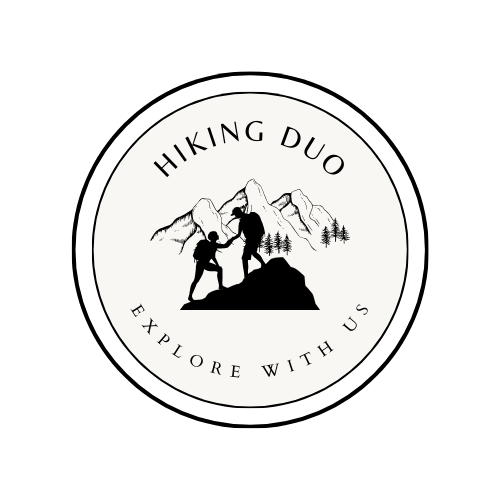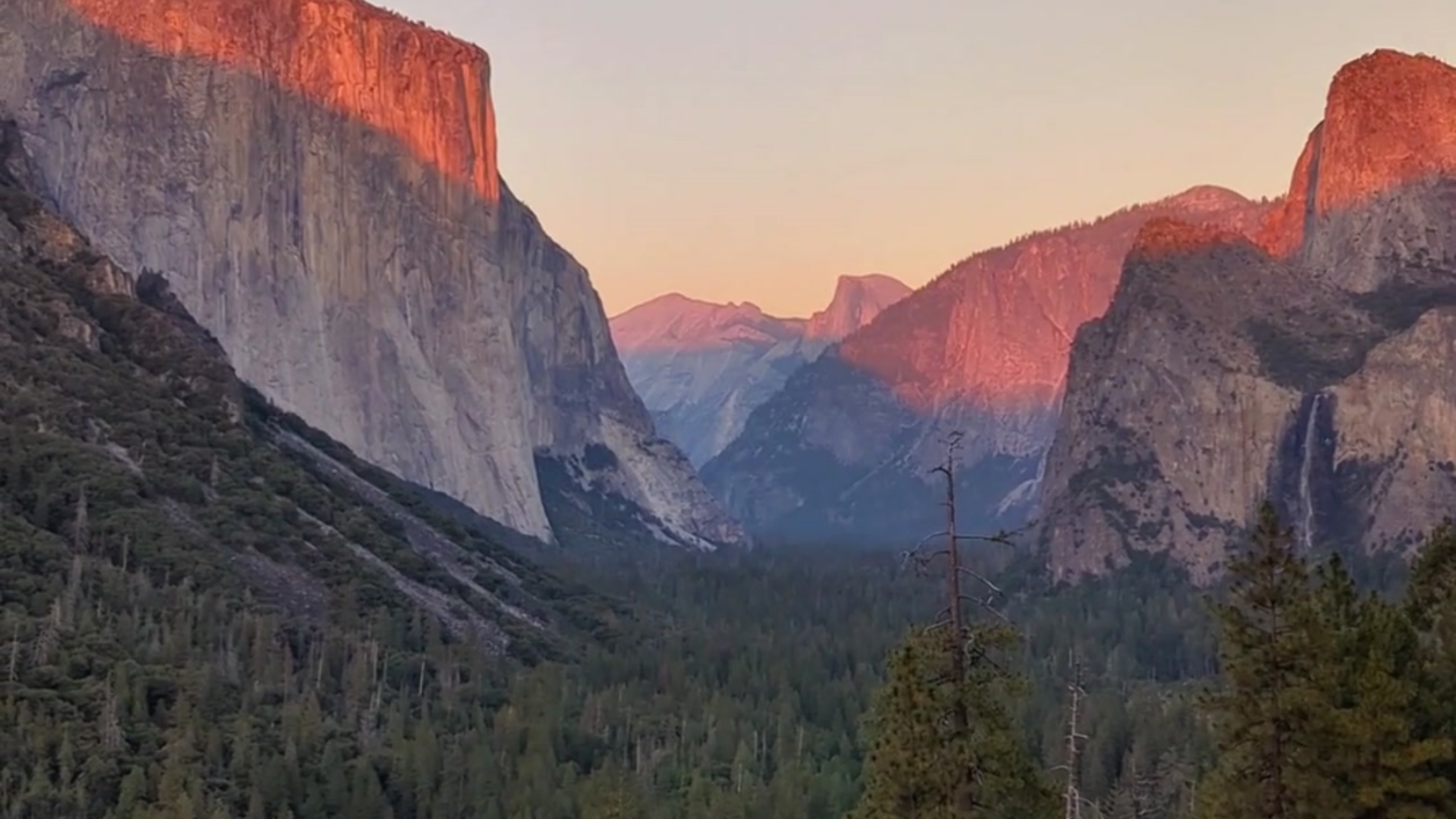Yosemite National Park, with its awe-inspiring granite cliffs, lush forests, and pristine alpine lakes, is a hiker’s paradise. Whether you’re a seasoned trekker or a casual nature enthusiast, Yosemite offers a variety of trails to suit every level of experience. Lace up your boots, grab your water bottle, and let’s explore the top ten hikes in this iconic national park.
Easy Hikes
1. Lower Yosemite Falls Trail
The Lower Yosemite Falls Trail offers visitors a leisurely stroll to experience the grandeur of one of North America’s tallest waterfalls. The trail provides a close-up view of the final 320-foot (98-meter) drop of Lower Yosemite Fall, creating a mesmerizing sight and a memorable hiking experience. During spring and early summer, when the waterfall is at its peak volume, hikers can expect a powerful and immersive encounter with nature’s force.
Length: Approximately 1 mile (1.6 kilometers) round trip.
Time Taken: 30 minutes
Elevation Gain: Approximately 50 ft (15 m).
Trailhead: The trail begins at the Yosemite Falls parking area, conveniently located near Yosemite Village.
Seasonality: Open year-round. Water is at its peak in spring and early summer. This waterfall is often dry from late July or August through October.
Crowd Rank: Expect high crowds, particularly during peak seasons and weekends. Visiting early in the morning or later in the evening can help avoid the crowds and provide a more tranquil experience.
Parking: The Yosemite Falls parking area tends to fill up quickly, so it’s recommended to arrive early to secure a parking spot. Alternatively, utilize the park’s shuttle system for easy access to the trailhead.
2. Mirror Lake Loop Trail
The Mirror Lake Loop Trail offers a serene stroll around the tranquil Mirror Lake, providing breathtaking views, particularly stunning during spring when it mirrors Half Dome. This leisurely hike meanders through picturesque scenery, offering a peaceful escape into Yosemite’s natural beauty.
Length: 2 miles (3.2 km) round trip to lake and back; 5 miles (8 km) loop around lake
Time Taken: 1-2 hours.
Elevation Gain: Minimal elevation gain of around 100 feet.
Trailhead: Mirror Lake Trailhead (shuttle stop #17).
Seasonality: Open year-round. Mirror Lake has little water much of the year and, while pleasant at any time of year, it is fullest in spring and early summer.
Crowd Rank: Moderately crowded, particularly during peak seasons and weekends.
Parking: Limited parking is available near the trailhead, so arriving early is advisable to secure a spot. Alternatively, utilize the park’s shuttle system for convenient access.
Notes:
- During winter and early spring, be cautious of slick conditions along the south side of the loop trail.
- Stay on the designated trail, especially during spring and early summer when water levels are higher.
- Mirror Lake is often referred to as Mirror Meadow in late summer due to the lack of water and the influx of grasses and sandy areas.
- Don’t forget to pack bug spray, sunscreen, and a hat for your hike. There are not many shaded areas, and with all the water, the mosquitoes are out with a force.
3. Cook’s Meadow Loop
Cook’s Meadow Loop offers a picturesque walk through the heart of Yosemite Valley, providing visitors with expansive views of iconic landmarks such as Yosemite Falls, Half Dome, Sentinel Rock, and Royal Arches. The trail meanders through lush meadows, offering a serene and tranquil environment for hikers to enjoy the natural beauty of the park.
Length: Approximately 1 mile (1.6 kilometers) loop.
Time Taken: About 30 minutes.
Elevation Gain: Flat.
Trailhead: Yosemite Valley Visitor Center (shuttle stop #5). Cook’s Meadow is also accessible from shuttle stop #6 (Lower Yosemite Fall Trailhead).
Seasonality: Open year-round.
Crowd Rank: Cook’s Meadow Loop tends to have lower levels of foot traffic compared to other popular trails in Yosemite Valley, offering a more peaceful and uncrowded hiking experience.
Parking: Parking is usually available near the Yosemite Valley Visitor Center, but availability may vary depending on the time of day and season.
Highlights:
- Enjoy stunning views of Yosemite Falls, Half Dome, Sentinel Rock, and Royal Arches from various vantage points along the trail.
- Boardwalks across the meadow provide opportunities for close-up views of the surrounding landscape and wildlife.
- Cook’s Meadow Loop is wheelchair accessible, offering inclusive access to all visitors.
Moderate Hikes
4. Vernal Fall and Nevada Fall Loop
The Vernal Fall and Nevada Fall Loop is a captivating trail that offers hikers the opportunity to experience two magnificent waterfalls on the Merced River up close. The trail provides breathtaking views of cascading water, lush greenery, and stunning landscapes throughout the journey. It is one of the most iconic and rewarding hikes in Yosemite National Park.
- Vernal Fall Footbridge:
- Distance: Approximately 1.6 miles (2.6 kilometers) round trip.
- Elevation Gain: 400 feet (120 meters).
- Difficulty: Moderate.
- Time: 1-1.5 hours.
- Top of Vernal Fall:
- Distance: Approximately 2.4 miles (3.9 kilometers) round trip (via Mist Trail).
- Elevation Gain: 1,000 feet (300 meters).
- Difficulty: Strenuous.
- Time: 3 hours.
- Top of Nevada Fall:
- Distance: Approximately 5.4 miles (8.7 kilometers) round trip (via Mist Trail).
- Elevation Gain: 2,000 feet (610 meters).
- Difficulty: Strenuous.
- Time: 5-6 hours.
Trailhead: The trailhead starts near the Happy Isles Nature Center and can be accessed via shuttle stop #16.
Seasonality: Open year-round.
Parking: Parking can be limited, especially during peak seasons. It is recommended to arrive early to secure parking or consider using the park’s shuttle service.
Highlights:
- Spectacular views of Vernal Falls and Nevada Falls from various vantage points along the trail.
- The Mist Trail offers a refreshing mist from the waterfalls, providing relief on warm days.
- Scenic beauty, including lush forests, granite cliffs, and vibrant wildflowers, throughout the hike.
- Opportunities for wildlife viewing, including birds, squirrels, and occasionally bears.
5. Sentinel Dome and Taft Point Trail
The Sentinel Dome and Taft Point Trail offers hikers a memorable journey through Yosemite’s remarkable landscapes, combining breathtaking vistas, granite cliffs, and expansive views of the valley below. This moderate trail provides an opportunity to explore two iconic destinations within Yosemite National Park in a single hike.
Length: Approximately 4.9 miles (7.9 km) round trip.
Time Taken: About 3-4 hours.
Elevation Gain: 1,000 ft (300 m).
Trailhead: The trail begins from the Glacier Point Road near the Sentinel Dome/Taft Point trailhead parking area.
Seasonality: These trails are only accessible when the Glacier Point Road is open, approximately late May through October or November. When Badger Pass Ski Area is open (mid to late December through March), the Glacier Point Road is groomed for cross-country skiing beyond the ski area.
Crowd Rank: Moderate.
Highlights:
- Scramble up Sentinel Dome’s granite slope to enjoy a breathtaking 360-degree view of the park.
- Enjoy magnificent views of Yosemite Valley, including El Capitan and Yosemite Falls near Taft Point.
Notes:
- Near Taft Point, you’ll see narrow fractures in the granite called joints. Be cautious near these fractures especially with children or in icy or slippery conditions, as drops can be up to 2,000 feet.
- The hike is mostly uphill to Sentinel Dome, with some rocky terrain and uneven surfaces.
- The best times to visit are from May through October.
- Unfortunately, dogs aren’t allowed on these trails.
6. Cathedral Lakes Trail
The Cathedral Lakes Trail offers a rewarding hiking experience amidst the stunning alpine landscapes of Yosemite National Park’s Tuolumne Meadows area. This moderately challenging trail leads visitors to the picturesque Upper Cathedral Lake, nestled beneath the towering peaks of the Cathedral Range. The trail showcases breathtaking scenery, including pristine alpine lakes, lush meadows adorned with wildflowers, and panoramic vistas of the surrounding granite peaks.
Length: 7 miles (11.3 km) round-trip.
Time Taken: 4-6 hours.
Elevation Gain: 1,000 ft (300 m).
Trailhead: Off Tioga Road.
Seasonality: Accessible only while Tioga Road is open to vehicles, from late May or early June to sometime in November.
Crowd Rank: Moderate.
Highlights:
- Enjoy the serene beauty of Upper Cathedral Lake, surrounded by granite cliffs and offering stunning reflections of the surrounding landscape.
- Take in panoramic vistas of the Cathedral Range, including iconic peaks such as Cathedral Peak and Echo Peaks, as well as expansive views of the surrounding meadows and forests.
- During the summer months, the trail is adorned with vibrant wildflowers, adding splashes of color to the landscape and enhancing the hiking experience.
- The Cathedral Lakes Trail serves as a gateway to the Cathedral Range and other backcountry destinations, making it an ideal starting point for multi-day backpacking trips.
Notes:
- Wilderness permits are required for overnight stays at Cathedral Lakes. Visitors should obtain permits in advance and adhere to all regulations regarding camping and backcountry travel.
- The trail begins at a high elevation, so hikers should be prepared for thinner air and possible altitude-related effects.
- Keep an eye out for wildlife along the trail, including marmots, deer, and a variety of bird species.
Difficult Hikes
7. Half Dome via Mist Trail
The Half Dome via Mist Trail is one of the most iconic and challenging hikes in Yosemite National Park, offering adventurers the opportunity to summit one of the park’s most recognizable landmarks. This strenuous trek combines breathtaking scenery, thrilling climbs, and unparalleled views, making it a bucket-list experience for outdoor enthusiasts. The route follows the Mist Trail, known for its misty conditions created by the cascading waters of Vernal and Nevada Falls, before ascending the sheer granite slopes of Half Dome.
Length: Approximately 16 miles (25.7 kilometers) round trip
Time Taken: 6-8 hours.
Elevation Gain: Strenuous, with an elevation gain of approximately 4,800 feet (1,463 meters).
Trailhead: Start from the Happy Isles Nature Center.
Seasonality: Accessible only while Tioga Road is open to vehicles, from late May or early June to sometime in November.
Crowd Rank: Moderate.
Highlights:
- The most thrilling part of the hike is the final ascent using the cables. Climb the iconic Half Dome with the help of these cables.
- Enjoy unparalleled views of Yosemite Valley, Nevada Falls, and Vernal Falls along the way.
- Permits are required for this hike. Plan ahead and secure your permit.
- Begin your hike early to avoid crowds and make the most of the day.
Notes:
- Be cautious on the cables section, especially during windy conditions.
- Surprisingly, there is decent cell service on top of Half Dome.
8. Clouds Rest Trail
The Clouds Rest Trail offers a challenging yet rewarding hiking experience in Yosemite National Park, showcasing stunning panoramic views from the summit of Clouds Rest. This iconic granite peak rises dramatically above Yosemite Valley, providing hikers with unparalleled vistas of the surrounding wilderness, including Half Dome, Tenaya Canyon, and the High Sierra skyline. The trail offers a thrilling combination of rugged terrain, steep switchbacks, and exhilarating ridge walks, making it a favorite among adventurous hikers seeking unforgettable vistas and solitude.
Length: 14.5 miles (23.3 km) round trip.
Time Taken: 6-8 hours.
Elevation Gain: 1,775 feet (540 meters).
Trailhead: The trail starts from the Sunrise Lakes trailhead on Tioga Road near Tenaya Lake.
Seasonality: Accessible only while Tioga Road is open to vehicles, from late May or early June to sometime in November.
Crowd Rank: Low.
Highlights:
- Enjoy one of Yosemite’s most stunning and wide-ranging 360-degree panoramic views. You’ll see landmarks stretching from Hawaii in the west to Nebraska in the east.
- Look down straight from the summit, taking in Yosemite landmarks such as Tenaya Lake, Half Dome, Mt. Hoffman, Sentinel Dome, North Dome, and more.
Notes:
- The Clouds Rest Trail can be strenuous and exposed, especially during hot summer months. Carry an adequate supply of water, sunscreen, and protective clothing, and be prepared for variable weather conditions, including high winds and afternoon thunderstorms.
9. Upper Yosemite Falls Trail
The Upper Yosemite Falls Trail The Upper Yosemite Falls Trail is one of Yosemite’s oldest historic trails, constructed between 1873 and 1877. It leads hikers to the top of North America’s tallest waterfall, which plunges dramatically 2,425 feet (739 meters) above the valley floor. The trail begins near the famous Camp 4 and ascends through oak woodland, offering stunning views of Yosemite Falls and the surrounding landscape.
Length: Approximately 6.6 miles (10.6 kilometers) round trip.
Time Taken: 6-8 hours.
Elevation Gain: A challenging ascent, gaining approximately 3,254 ft feet (991 meters) in elevation.
Trailhead: The trail starts near the famous Camp 4 and ascends along switchbacks through oak woodland.
Seasonality: Open year-round. In spring, when the waterfall is at its peak, this hike is stunning, and you may even get wet from the spray of the waterfall during a section of the hike. In summer, conditions are hot and dry, and the loose decomposed granite along the trail can be slippery. Keep in mind that by August, the water levels are low and you may only see a trickle here.
Crowd Rank: Moderate.
Highlights:
- Spectacular views looking down from the top of Yosemite Falls, consisting of three sections: upper falls, middle cascade, and lower falls.
- Yosemite Fall Overlook offers thrilling views of Yosemite Valley and an up-close look at the amazing waterfall.
- Along the way, admire the rocky cliffs of Eagle Peak to your left—a popular rock climbing destination and home to eagles.
- Eagle Peak: Along the way, take a look at the rocky cliffs of Eagle Peak to your left—a popular rock climbing wall and home to eagles.
- Yosemite Point: For those with remaining energy, continue to Yosemite Point for more great views of North Dome and the rest of the valley.
Notes:
- This trail can become very hot mid-day in the summer. By starting as early as possible, you will be able to hike during the cooler part of the day. The upper portion of the trail is exposed, receiving no shade until late afternoon or early evening.
- Sprained ankles and knee injuries are common on this trail. There are many areas of loose sand mixed with rocky terrain, which makes for slippery footing.
- Stay on the trail; there are numerous steep drop-offs and ledges off-trail.
- Wilderness permits are required for overnight stays. Register early if planning to stay overnight.
10. Four Mile Trail
The Four Mile Trail is a challenging yet rewarding hike that ascends from Yosemite Valley to Glacier Point, offering stunning views of the valley and iconic landmarks along the way. This strenuous trail is known for its steep elevation gain and breathtaking panoramas of Yosemite’s granite cliffs, waterfalls, and lush forests.
Length: Approximately 4.8 miles (7.7 kilometers) one way to Glacier Point (9.6 miles round trip).
Time Taken: 3-4 hours one-way, 6-8 hours round trip.
Elevation Gain: 3,200 feet (975 meters).
Trailhead: Four Mile Trailhead along Southside Drive in Yosemite Valley (serviced by the free Valleywide Shuttle, stop #11).
Seasonality: Opens in May and closes below Union Point due to treacherous conditions after significant snow accumulation (usually by November or December).
Crowd Rank: Moderate.
Highlights:
- Spectacular views of Yosemite Valley, El Capitan, Yosemite Falls, and eventually Half Dome.
- Side trip to enjoy the view of Yosemite Valley from Union Point (located two-thirds of the way up).
Notes:
- The trail is steep and challenging, with numerous switchbacks and exposed sections, making it suitable for experienced hikers in good physical condition.
- Hikers should carry an adequate supply of water, snacks, sunscreen, and appropriate clothing, as weather conditions can vary throughout the hike.
- The trail may be closed during winter months due to snow and ice, so it’s essential to check current trail conditions before embarking on the hike.
- If hiking one way, arrange for transportation at the other end (no free shuttle system between Glacier Point and Yosemite Valley).
Conclusion:
Yosemite National Park boasts an abundance of hiking trails suitable for every skill level, allowing visitors to immerse themselves in the park’s stunning scenery and natural wonders. Whether you prefer an easy stroll or a challenging ascent, Yosemite’s diverse landscapes offer endless opportunities for adventure and exploration. So lace up your hiking boots, pack plenty of water and sunscreen, and embark on an unforgettable journey through one of America’s most beloved national parks. Remember to plan ahead, stay hydrated, and be prepared for varying trail conditions. Whether you’re chasing waterfalls, summiting peaks, or exploring hidden lakes, Yosemite’s trails offer something magical for every hiker. Happy trails!





